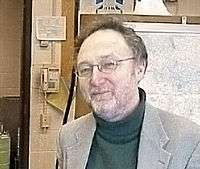David Larbalestier
| David Larbalestier | |
|---|---|
|
David C. Larbalestier | |
| Born | England |
| Residence | Tallahassee, FL |
| Nationality |
|
| Fields | Materials Science |
| Institutions | Florida State University |
| Alma mater |
Imperial College London University of London |
| Doctoral advisor | H.W. King |
| Known for | Materials research for superconductivity applications |
David C. Larbalestier is an American scientist who is known for his research in superconducting materials for magnets and power applications. He is currently a Professor of Mechanical Engineering and Director of the Applied Superconductivity Center at the National High Magnetic Field Laboratory at Florida State University. He also holds emeritus status in the Materials Science and Engineering department at the University of Wisconsin–Madison, which was his academic home until 2006. He is a member of the National Academy of Engineering. His materials research interests have led to improvements in the superconducting properties of many materials, including NbTi, Nb3Sn, MgB2, YBCO, and BSCCO.
Academic career
- 1965 BSc (Physical Metallurgy), Imperial College London, University of London
- 1970 PhD (Physical Metallurgy), Imperial College London, University of London (advised by Dr. H.W. King)
- 1970-1972 Scientific Staff, Metallurgy Division, Battelle-Geneva Laboratory (Switzerland)
- 1973-1976 Research Fellow and Senior Scientific Officer, Rutherford High Energy Laboratory-UK
- 1976-2006 Professor, Dept. of Materials Science and Engineering (Associate Professor 1978, Professor 1981, Shubnikov Professorship 1990, Grainger Professorship 1996), University of Wisconsin–Madison
- 1981-1992 Associate Chairman, Department of Materials Science and Engineering, University of Wisconsin–Madison
- 1989-1996 Director, NSF-supported Materials Research Group in High Temperature Superconductivity, University of Wisconsin–Madison
- 1991-2006 Professor, Department of Physics, University of Wisconsin–Madison
- 1991–present Director, Applied Superconductivity Center (Associate Director 1982 - 1991), University of Wisconsin–Madison
- 2000 Summer: Visiting Professor, Department of Physics, University of Geneva, Switzerland
- 2000 Fall: Senior Engineering and Physical Sciences Research Council Fellow, Imperial College London, UK.
- 2006–present Emeritus Professor, Department of Materials Science and Engineering, University of Wisconsin–Madison
- 2006–present Professor, Department of Mechanical Engineering, Florida State University
- 2006–present Chief Materials Scientist, National High Magnetic Field Laboratory, Florida State University
Awards and honors
- Matthey Prize for best PhD thesis in Metallurgy, Imperial College London, University of London, 1970.
- Industrial Research IR-100 Award, 1979, for the development of the first Nb3Sn NMR (470 MHz) superconducting magnet and spectrometer. (Joint with C.A. Scott, J.E. Magraw, R. Wheatley and P. Hanley.)
- LV Shubnikov Chair - Wisconsin Alumni Research Foundation Professorship – UW Graduate School Chair (1990)
- Fellow of the American Physical Society (1990)
- Institute of Electrical and Electronic Engineers (Nuclear and Plasma Sciences Society) Particle Accelerator Science and Technology Award for the Development of High Current Density Nb-Ti conductors for Accelerator Magnets (jointly with R. M. Scanlan, 1991)
- Grainger Professor of Superconductivity – The College of Engineering (1996)
- Council for Chemical Research, Research Collaboration Award 2000 (Award given to the Wire Development Group, of which DCL was a founding member, for its pioneering work on the materials science of (Bi,Pb)2Sr2Ca2Cu3Ox).
- The IEEE award for continuing and significant contributions in the field of applied superconductivity (2000)
- Fellow, Institute of Physics, United Kingdom (2001)
- Member, National Academy of Engineering (2003)
- The International Cryogenics Materials Conference Lifetime Achievement Award (2007)
External links
- National High Magnetic Field Laboratory Profile
- Applied Superconductivity Center
- Florida State University
- University of Wisconsin–Madison
This article is issued from Wikipedia - version of the 3/20/2016. The text is available under the Creative Commons Attribution/Share Alike but additional terms may apply for the media files.
